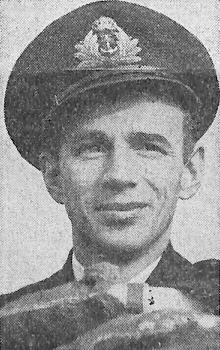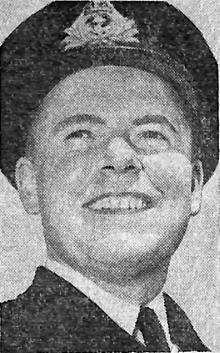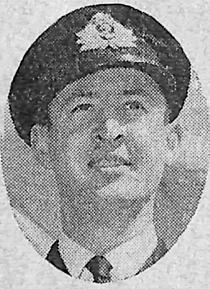HMCS Chilliwack, and the Sinking of U-744.
In April 2021, I received an email from Jamie MacMillan, who said in part: " When my dad passed in 2008 he left a trunk of old war letters, pictures, newspaper clippings etc., which I have been scanning and organizing for years. The letters cover his navy training starting in June of 1942, to his first deployment on the Chilliwack starting Aug of 1943, and then for the period until D-Day when he was reassigned to the Assiniboine till the remainder of the war – finishing in Nov. 1945 . . . . . "
The news story below is probably the complete RCN news release, dated Wednesday, May 31, 1944. It is a compilation of several different news clippings sent me by Jamie MacMillan.
Canadians Send Nazi U-Boat To Bottom

Lieut. Comdr. William P. Moffatt, RCNVR, Commanding Officer
of HMCS Fennel.

Lieut. K.E. Cann, RCNVR

Lieut. R.O. Blackford

Ldg Seaman A.G. Phillips
German Submarine Sent
To Bottom of Atlantic
By Canadian Navy Ships
OTTAWA, May 31-(R.C.N. Press Release)-After a desperate effort to outwit its pursuers, a German submarine was finally forced to the surface and destroyed in a recent North Atlantic action by a group of Canadian escort warships, assisted by a Royal Navy destroyer, it was announced today by Hon. Angus L. Macdonald, Minister of National Defence for Naval Services.
Prisoners Taken
A number of prisoners were taken from the U-boat in whose destruction HMCS Chilliwack, one of Canada's oldest corvettes played a major role. Chilliwack's Commanding Officer is Lieut. Cdr. Clifton R. (Tony) Coughlin, RCNVR, of Ottawa. The other Canadian ships involved in the action were the corvette Fennel (Lieut. Cdr. William P. Moffat, RCNVR, of Montreal); the frigate St. Catharines, in which the senior officer of the escort, Commander P.W. Burnett, R.N., of Barrow-on-Furness, England, was sailing; the destroyers Gatineau (Lieut. Cdr. H.V.W. Groos, R.C.N., of Victoria, B.C.) and Chaudiere (Lieut. Cdr. Pat Nixon, R.C.N., of Victoria, B.C.). The R.N. destroyer was Icarus (Lieut. Cdr, Richard Dyer, R.N., formerly of Vancouver and now of Kent, England.)
The action began when Gatineau, about to leave the convoy because of distiller defect, obtained contact with an object which Lieut. Cdr. Groos was confident was a U-boat. "We thought the submarine was coming in to attack the convoy, so close did it come," he said. St. Catharines, the senior ship carried out a depth charge attack. Then Chilliwack joined in and I brought Gatineau in and dropped a heavy charge.
Spotted Submarine
"The U-boat captain was a wily bird and tried to confuse us by his underwater tactics, but we stayed right with him. Unfortunately Gatineau wasn't in at the kill. The distiller defect forced us to leave the scene before the U-boat surfaced. I believe that as we picked him up he fired a torpedo at us, because we saw the wake of one come very close."
Chilliwack, Fennel and St. Catharines, stayed right on throughout the action, almost from the moment of first contact until the submarine finally broke surface. When it did appear Chilliwack spotted it first. "I was standing on the bridge chatting with Lieut. Tim Dunn, (of St. Petronille, Isle d'Orleans, Que.) my first lieutenant" said Lieut. Cdr. Coughlin, her comanding officer. I was sure that we had the U-Boat trapped. Just then Lieut. Dunn cried 'Here he comes.' The submarine was dead ahead and we closed at full speed.
"As the U-boat was sighted I yelled to someone to man one of the bridge Oerlikons. Signalman Jack Starr of Winnipeg, grabbed it and gave the Germans a hot time of it. He was a ball of fire all the way through.
"At first I intended to ram, but as we went in I altered course and passed directly under the U-boat's stern" Lieut. Coughlin added. "Then I brought Chilliwack around to starboard to allow all the guns to bear. We were maintaining terrific fire and all the other ships were joining in. The U-boat crew did not have a chance to man their guns. The first salvo from our four inch gun wiped a twin mounting right off the conning tower and killed the U-boat Captain who was first to emerge from the hatch. The conning tower itself soon looked like a sieve so many shells hit it. The Nazis then started to abandon the sub.
Saw Terrified Expressions
Asked how close he approach to the U-boat Lieut. Cdr. Coughlin said "We were as close as we could possibly get and all our guns were blazing away. Our bow almost touched the U-boat's side on one occasion. You could see the terrified expressions on the Nazi's faces. They did not like it one bit and I could hardly blame them. They were lucky to be alive at all. The prisoners we picked up soon recovered. They were fit and hard."
Summing up the action, Lieut. Cdr. Coughlin said: "Chilliwack was first to see the U-boat and first to open fire and score a hit. All our ships were in there pitching and doing a fair amount of hitting when their turn came to bat." He was loud in his praise of Commander Burnett, whose display of tactics won the plaudits of all commanding officers in the group. "He manoeuvred the ships as if they were mechanical soldiers and had the U-boat in the middle all the way," he said. "He's one of the finest officers you'd want to work with and we are all proud to have served under him."
"Great Piece of Team Work"
Lieut. Cdr. Moffat, commanding officer of Fennel declared "We needed patience to stay around and when the sub. finally came to the surface Chilliwack was in the best position to grapple with it. We dropped lots of depth charges and I'm sure we shook him up plenty. We were also able to pump some four-inch and Oerlikon stuff at him."
"It was a great piece of team work and a fine triumph for the Canadians of whose group I have the honour to be Senior Officer," said Commander Burnett. "As Senior Officer I was sailing in St. Catharines, the new commanding officer, Lieut. A, H. Easton. D.S.C., RCNR, not having had time to report by the time we sailed with the convoy. The flrst lieutenant, Lieut. W.D. Spicer, RCNVR, of Regina, carried out the duties of commanding officer in a most efficient manner. The patience displayed brought its reward. I only hope that we can go out and do the same thing again."
Lieut. Cdr. Nixon said Chaudiere "happened to be there" when the U-boat was forced to surface. "We all let him have it;" he said. "It was a spectacular show. We added a couple of depth charge patterns to the already heavy load dropped on the submarine. The rescue work was a bit tricky, the weather having spoiled up during the afternoon. Fennel, Chilliwack and St. Catharines all lost whalers, so we lowered our motorboat and whaler and between them they managed to pick up all the crews as well as Nazis, thirteen of whom were clinging to or sitting in a pontoon."
Asked what happened to the convoy. Lieut. Cdr. Nixon declared laconically: "Nothing, exactly nothing. We brought it to the United Kingdom without a scratch, and it was a big one too."
The news story below, dated July 18, 1944, is from an unknown newspaper.
Chase And Kill Of U-Boat Win Honors For 24 Men

P.O. Ed. Badger.
Forced to Surface, Sunk
by Shells and
Prisoners
Taken – Three Toronto
Men Listed
Ottawa, July 18 – Canada's anti- U-boat fleet was honored to-day when Navy Minister Macdonald announced award of six medals and 18 mentions in despatches. No citations were given.
The decorated men served with a group of Canadian ships that trailed a German submarine, blew it to the surface, sank it with shellfire and then took a number of prisoners. The British destroyer Icarus aided in the action.
The veteran Canadian corvette Chilliwack, which played the major role in the fight, had the largest representation – six names – in the list. Her commanding officer, Lt.- Cmdr. C.R. Coughlin, Montreal and Ottawa, won the Distinguished Service Cross, while Engine Room Artificer A. Longbottom, Moose Jaw, and Signalman J.R. Starr, Winnipeg, won Distinguished Service Medals.
MENTIONED IN DESPATCHES
Members of her crew mentioned in despatches were Lieut. T.H. Atherton, Halifax, Leading Seaman L.J. Lauder, Montreal, and Leading Seaman C.D. Boyd, Saint John, N.B.
The crew of another expert U-boat hunter, the frigate St. Catharines, won four honors. Lieut. W.G. Gooderham, Vancouver, won the D.S.C., and Petty Officer Edward Badger, Toronto, the D.S.M. Chief Stoker J.E.F. Parker, Red Deer, Alta., and Leading Seaman N.L. Bourne, Vancouver, were mentioned in despatches.
A.B. F.D. Craig, Kamsack, brought a D.S.M. honor to the destroyer Gatineau while four of her ship's company were mentioned in dispatches; Lt.-Cindr. H.V W. Groos, her commanding officer, of Victoria and Halifax; Lieut. Frank Harley, Glasgow, N.S., Leading Stoker G.H. McGinn, Kamloops, B.C., and Chief Engine Room Artificer N.J. Laderoute, Fort William.
These five members of the crew of the corvette Fennel were mentioned in dispatches: Lt.-Cmdr. W.P. Moffat, commanding officer, of Montreal and Halifax; Lieut. T.C. Todd, Victoria and Chester, N.S.; Chief Engine Room Artificer J.E. Williams, Toronto and Victoria; Leading Seaman E.R. Brace, Verdun, Que., and Telegraphist E.H. Butler, Toronto.
These four members of the destroyer Chaudiere were mentioned in dispatches: Lt.-Cmdr. C.P. Nixon, commanding officer, of Victoria; Lieut. D.S. Boyle, Bathgate, Scotland; Chief Engine Room Artificer J. Miller, Halifax; Chief Petty Officer Telegraphist A.J. Carrington, Calgary and Victoria.
The first accounted destruction of the submarine singled out Sigmn. Starr – at present at the naval signal school at St. Hyacinthe, Que. – for his prompt action in manning an oerlikon gun and opening fire on the submarine after it had been brought to the surface by depth charge attacks.
"He was a ball of fire all the way through," said Lt.-Cmdr. Coughlin.
GATINEAU STARTED IT
The action started when the Gatineau obtained an underwater contact which her commanding officer, Lt.-Cmdr. Groos, was confident was a sub. A moment later the wake of a torpedo was seen close to the Gatineau. Depth charge attacks were made by Gatineau, St. Catherines, Chilliwack and Fennel.
When the U-boat surfaced, such terrific fire was brought to bear that the sub crew did not have a chance to man its guns.
The news story below, with date missing, is from The Toronto Evening Telegram.
Victories Over Robots, U and E Boats Win Praise and New Job for Gatineau

P.-Lt. Frank Lovett
89 Charles St. West, Toronto

B'Sn. Lloyd (Hoot) Gibson
Stratford, Ont.

S-Lt. Norman Millen
338 Glen Manor Drive, Toronto

S-Lt. Harry Taylor
Hamilton

Lt. (E) John Savory, O.B.E.
Hamilton

Surgeon-Lt. David M. Bean
Waterloo

Lt. William Leslie
Kingston
All Members of the Canadian destroyer, HMCS Gatineau's company, these Toronto and Ontario men, now back in Canada, saw plenty of invasion action from the decks of their ship. As well as taking part in the D-Day and subsequent operations, they also helped destroy one German submarine and joined in the attack on another, probably destroyed an enemy E-boat and shot down flying bombs.
OTTAWA, Aug. 15–With a record of more than 80 per cent of her time at sea since commissioning, the Royal Canadian Navy destroyer, HMCS Gatineau, has been assigned new duties after months of anti-submarine patrol, invasion work and channel operation, during the assault on France, Hon. Angus L. Macdonald, Minister of National Defense for Naval Services, revealed to-day.
Gatineau's experiences include the probable destruction of an enemy E-boat in the English Channel, "assists" in successful attacks on two U-boats and battles with some of the first robot bombs the enemy hurled toward London and the south coast of England while the destroyer was on invasion patrol duty.
The minister's statement noted that during the destroyer's recent operations five members of her complement had received operational citations. Able Seaman Frank Craig, RCNVR, of Kamsack, Sask., received the Distinguished Service Medal for outstanding work in connection with the destruction of an enemy submarine. Lt. Cmdr. Harold V.W. Groos, RCN, of Victoria and Halifax, commanding officer; Lt. (E) Frank Harley, RCNR, of Glasgow, Scotland, and Halifax; Engineroom Artificer Norbert J. Laderoute, RCNR, Fort William, and Ldg. Stoker, now Stoker P.O. George H. McGinn, RCN, of Kamloops, were mentioned in dispatches for outstanding performances of duty while engaging the enemy.
Gatineau is the former HMS Express with a long record of sea action in this war. She was taken over by the Canadian Navy and recommissioned a year ago and was engaged for several months on mid-ocean convoy escort work prior to her assignment to U-boat patrol and invasion operations in British waters. During the past six months the "sea-going express" has been at sea no less than 143 days.
In a pre-invasion sweep with four other Canadian ships, Chaudiere, Chilliwack, Fennel, and St. Catharines, and the Royal Navy destroyer Icarus, Gatineau took part in her first submarine sinking.
"Our asdic operator picked up contact and was sure he had a submarine," the captain said. "I passed the word on to the other ships in the group and we went to work dropping depth charges.
"The hunt was the longest of which I have ever heard," said Groos. "Lasting 36 hours, the chase was one in which we knew we were up against a clever U-boat commander. We found out later he was a member of the regular German Navy and he certainly was well up on every trick known in submarine warfare. The U-boat captain, incidentally, was shot later when he resisted a boarding party from HMCS Chilliwack."
The night when, a few days after the invasion got under way, they encountered and attacked three enemy E-boats, was a highlight that few will forget. "Jerry just about got us that time," said C.P.O. William Holmes, RCN, of Victoria. "We were on patrol not far off the invasion coast when the E-boats suddenly appeared. One of them fired a torpedo which we just managed to avoid. We gave chase and opened fire, but they put down a smoke screen and it was impossible to see the results. However, after several salvos we heard and saw a huge explosion.
"The Germans then made the mistake of zig-zagging back and forth between the smoke floats and every time they passed through one of the lanes our Oerlikons could train right on them," Lt.-Cmdr. Groos stated. "Our guns just couldn't have missed them because they were very close and the bullets were just flying in on them in swarms."
Gatineau's guns were among the first to be trained on the now famous robot bombs. "They were a puzzling sight at first," said Lt. Maurice Chadwick, RCN, executive officer of Gatineau. "They whizz by so fast you can hardly keep your eye on them."
"We think we got a couple," said Boatswain A.S.C.O. Lloyd "Hoot" Gibson, of Stratford.
"We definitely got one," said Groos. "It came on a long glide straight on, but was not going to hit us. The bomb twisted sideways and went straight down into the sea about 500 yards away from the ship. We could feel the concussion on our faces as it exploded."
Of the crew of seven officers and 65 ratings from Ontario, 18 are from Toronto and one from New Toronto.
Can you provide details or corrections?
Please email Charlie Dobie.